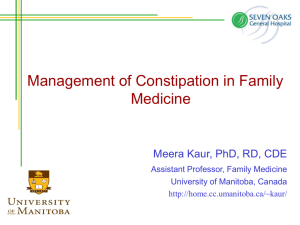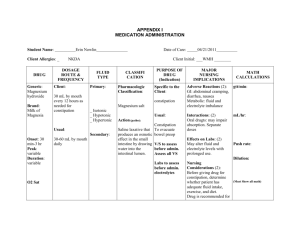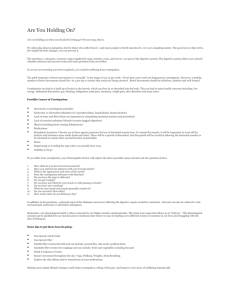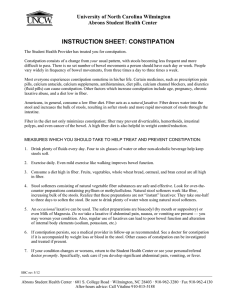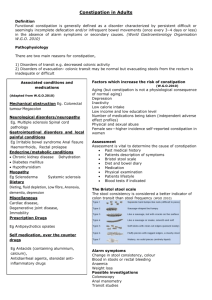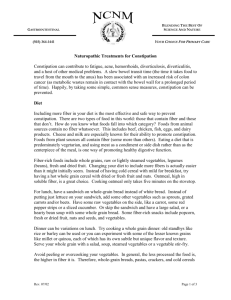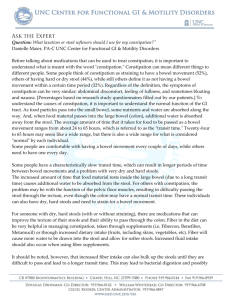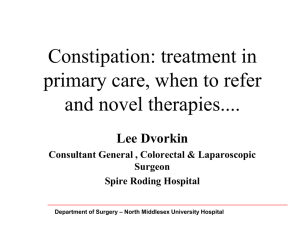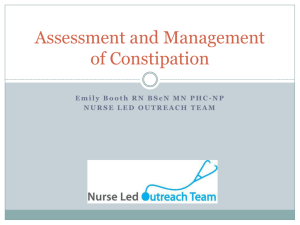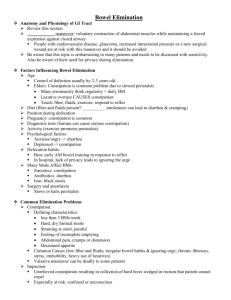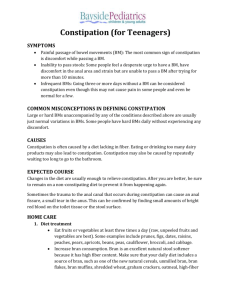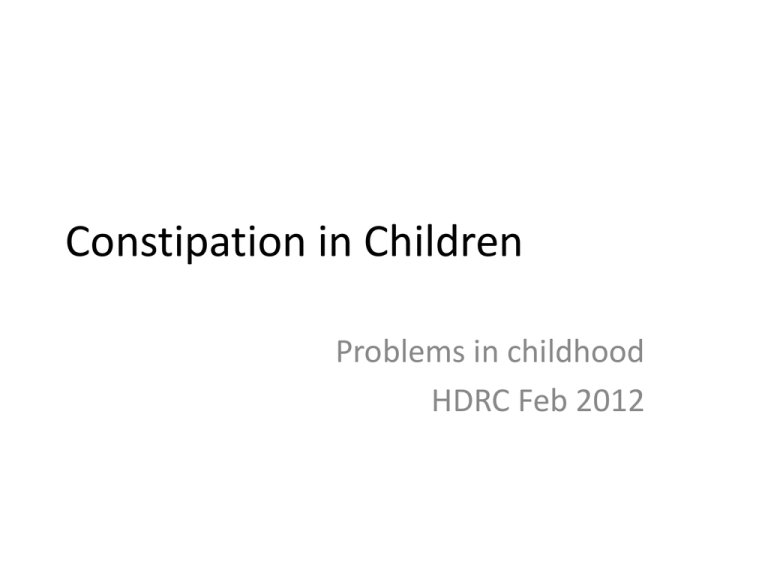
Constipation in Children
Problems in childhood
HDRC Feb 2012
Outline
•
•
•
•
•
Normal bowel habit
Diagnosis of constipation
When to be worried – red flags
Management
Advice/support
Constipation
• Very common problem in children
• Affects up to 5-30% of children (diagnosis
dependent).
• Only a third will develop chronic symptoms
requiring referral
• Parent/guardian’s anxiety often outweighs the
symptoms.
Normal Bowel habit
• More significant variation in babies : stool
with each feed or a stool every few days.
• Formula fed > Breast fed.
• Once weaned variation is largely due to diet.
• Focus on the :
– passage of stool rather than frequency.
– Change in the individual’s bowel habit.
Bristol Stool Chart
Causes for constipation
• Idiopathic
– Diet
– Stool holding
– Emotional problems/phobia.
• Due to underlying disease
–
–
–
–
Neurological conditions
Cystic Fibrosis
Hirsprungs or abnormal bowel development
Side effects of medications
• Rare: maltreatment or abuse.
Key points indicating constipation
Findings in a child <1 year
Findings in child >1year
Key points indicating constipation
Findings in a child <1 year
Findings in child >1year
• <3 type 3 or type 4
stools/week
(excl. Breast fed babies after 6wk)
•
•
•
•
•
•
•
•
•
•
Passage of hard large stools
Type 1 ‘rabbit droppings’
Distress on stooling
Bleeding with hard stool
Straining
Anal fissures
•
•
•
•
•
•
<3 type 3/4 stools/week
Overflow/soiling/smelly
Type 1 rabbit droppings
Large infrequent stools that
block the toilet
Poor appetite
Waxing and waning abdo pain
Retentive posturing
Straining /anal pain
Anal fissures
Blood with bowel movements
Signs suggesting non-idiopathic
constipation - History
• Red Flags:
–
–
–
–
Present at birth /first few weeks of life
Failure to pass meconium with 48hrs of birth
Ribbon stools
Previously unknown/undiagnosed leg weakness or
motor delay
– Abdo distension and vomiting
• Amber Flags
– Faltering growth
– Disclosure /evidence raising concerns over
maltreatment
Signs suggesting non-idiopathic
constipation - Examination
• Red Flags:
– Abnormal appearance/position/patency of anus
– Gross abdo distension
– Abnormal spinal/gluteal examination
– Lower limb deformities
– Abnormal reflexes
Investigate possible underlying causes
• Red flags : Refer urgently – do not treat.
• Faltering growth: Treat and test
– Treat constipation
– Test for coeliac disease and hypothyrodism.
• Possible maltreatment: risk assess and child
protection
• Consider referral if inadequate response to
optimum treatment with 4 week.
Tips for management of early
constipation
• Drinks:
– Ensure adequate fluid intake
– Additional water between feeds
– Diluted fruit juice or pureed fruit/veg
– Avoid fizzy/sugary drinks/milk to quench thirst
– Fruit juices containing fructose/sorbitol have a
laxative action.
Tips for management of early
constipation
• Diet
– High fibre diet
– Offer fruit with meals
– Add powered bran to foods
• Regular toileting
– A set time, and not rushed.
– Reward system when stool passed in toilet/potty.
– Remain relaxed when accidents happen.
Management of idiopathic
constipation - Impacted
Step 1
• Movicol Paediatric Plain
• Escalating dose regime mixed with a cold drink
Step 2
• If no disimpaction after 2 weeks
• Add stimulant laxative
Step 3
• If unable to tolerate Movicol
• Substitute stimulant laxative +/- osmotic laxative
Management post disimpaction/
constipation without impaction.
• Same steps as above.
• Once disimpacted, maintenance doses approx
half the disimpaction dose.
• Continue at maintenance dose for several
weeks after regular bowel habit established.
• Gradual reduction thereafter, over months.
• Rare occasions where laxatives may be
required for years.
Advice / Support
• Health Visitor
• NICE – guidance for patients and carers
• ERIC ( Educational Resources for Improving
Child Continence).

